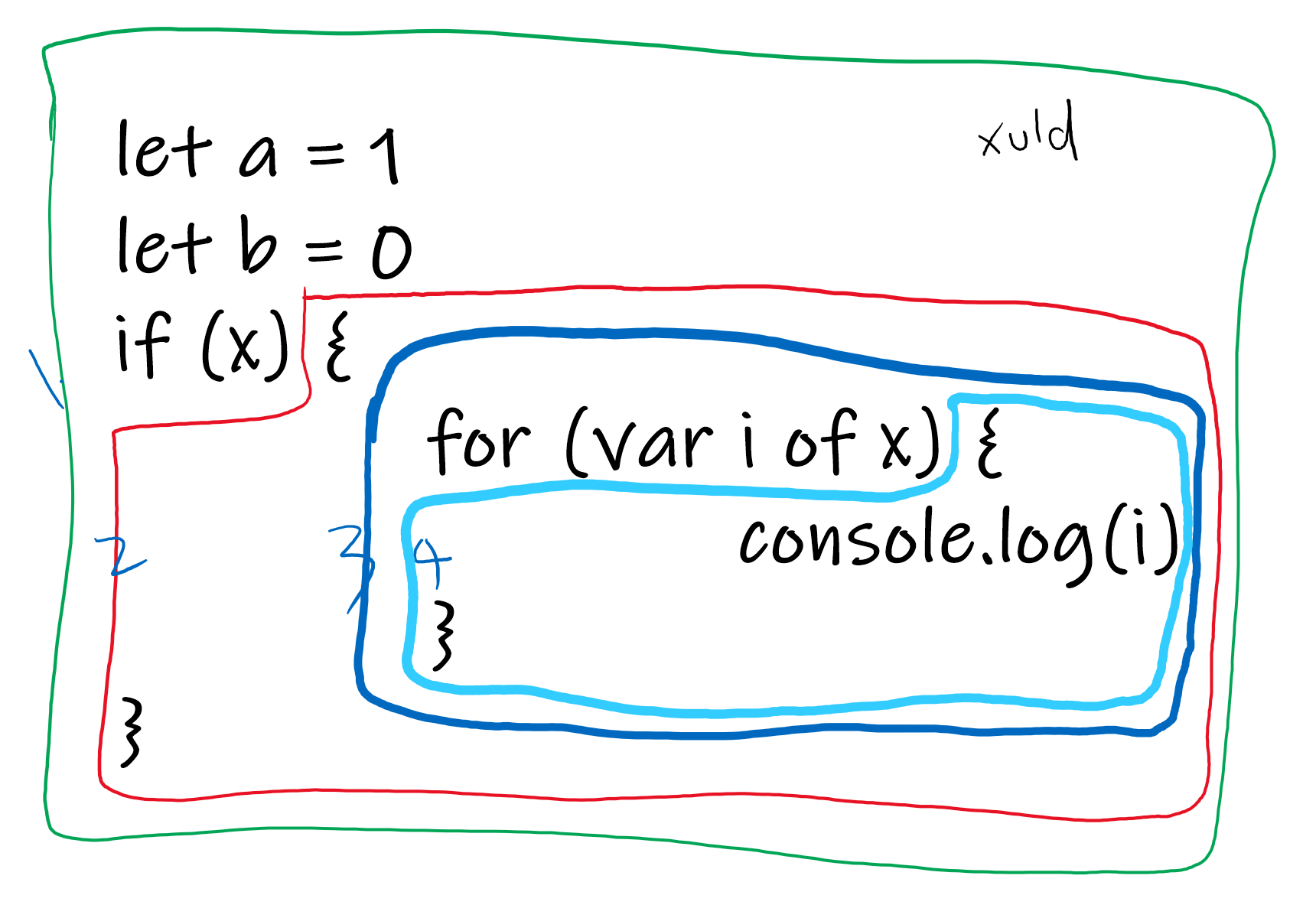在上一节主要介绍了语法树的解析生成。就好比电脑已经听到了“你真聪明”这句话,现在要让电脑开始思考这句话的含义——是真聪明还是假聪明。
这是一个非常的复杂的过程,接下来将有连续几节内容介绍实现原理,本节则主要提前介绍一些相关的概念。
符号
在代码里面,可以定义一个变量、一个函数、或者一个类,这些定义都有一个名字,然后在其它地方可以通过名字引用这个定义。
这些定义统称为符号(Symbol)(注意和 ES6 里的 Symbol 不相干)。

当在代码里写了一个标识符名称(变量名),这个名称一定可以解析为某个符号(可能是变量、参数、函数或其它的,可能是用户自己写的,也可能系统自带),如果无法解析,那一定是一个错误。
一个符号一般和一个声明节点对应,比如一个变量符号就对应一个 var 声明节点或 let/const 声明节点。
可能存在一个符号对应多个声明节点的情况,比如:
class A{}
interface A{}
同名的类和接口只产生一个符号 A,但这个符号拥有两个声明。
可能存在一个符号没有源声明节点的情况,比如:
type T = {[key: string]: any}
T 有无限个成员,每个成员都是没有源声明节点的。
TS 中符号的定义:
export interface Symbol { flags: SymbolFlags; // Symbol flags escapedName: __String; // Name of symbol declarations: Declaration[]; // Declarations associated with this symbol valueDeclaration: Declaration; // First value declaration of the symbol members?: SymbolTable; // Class, interface or object literal instance members exports?: SymbolTable; // Module exports globalExports?: SymbolTable; // Conditional global UMD exports /* @internal */ id?: number; // Unique id (used to look up SymbolLinks) /* @internal */ mergeId?: number; // Merge id (used to look up merged symbol) /* @internal */ parent?: Symbol; // Parent symbol /* @internal */ exportSymbol?: Symbol; // Exported symbol associated with this symbol /* @internal */ nameType?: Type; // Type associated with a late-bound symbol /* @internal */ constEnumOnlyModule?: boolean; // True if module contains only const enums or other modules with only const enums /* @internal */ isReferenced?: SymbolFlags; // True if the symbol is referenced elsewhere. Keeps track of the meaning of a reference in case a symbol is both a type parameter and parameter. /* @internal */ isReplaceableByMethod?: boolean; // Can this Javascript class property be replaced by a method symbol? /* @internal */ isAssigned?: boolean; // True if the symbol is a parameter with assignments /* @internal */ assignmentDeclarationMembers?: Map<Declaration>; // detected late-bound assignment declarations associated with the symbol }
其中,declarations 表示关联的源节点。valueDeclaration 则表示第一个具有值的源节点。
注意两者都可能为 `undefined`,源码中之所以没将它们标上 `?`,主要是因为作者懒(不然代码需要经常判断空)。
其中,escapedName 表示符号的名称,名称本质是字符串,TS 在源码中有一些内部的特殊符号名称,这些名称都以“__”前缀,如果用户本身就定义了名字带__的,会被转义成其它名字,所以 TS 内部将转义后的名字标记成 __String 类型,运行期间它本质还是字符串,所以不影响性能。
作用域
允许定义符号的节点叫作用域(Scope),比如全局范围(源文件),函数,大括号。
在同一个作用域中,不能定义同名的符号。
作用域是一个树结构,查找变量时,先在就近的作用域查找,找不到就向外层查找。
如图共四个作用域:

仔细观察会发现,if 语句不是一个作用域,但 for 语句却是。
语言本身就是这么设计的,因为在 for 里面可以声明变量。
流程节点
流程节点是执行流程图的组成部分。
比如 a = b > c && d == 3 ? e : f 的执行顺序:

由于 JS 是动态语言,变量的类型可能随执行的流程发生变化,因此在分析时需要知道整个代码的执行顺序。
流程节点就是拥有记录这个顺序的对象。
开始流程
开始流程是整个流程图的根节点。
// FlowStart represents the start of a control flow. For a function expression or arrow // function, the node property references the function (which in turn has a flowNode // property for the containing control flow). export interface FlowStart extends FlowNodeBase { node?: FunctionExpression | ArrowFunction | MethodDeclaration; }
代码总是从一个函数开始执行的,所以开始流程也会记录关联的函数声明。
标签流程
如果执行的时候出现判断,则可能从一个流程进入两个子流程,即流程跳转,跳转的目标叫标签流程:
// FlowLabel represents a junction with multiple possible preceding control flows. export interface FlowLabel extends FlowNodeBase { antecedents: FlowNode[] | undefined; }
缩小类型范围的流程
理论上,每行节点都可能对变量的类型有影响,比如上图例子中,e 所在的位置在流程上可以确认 d == 3。
那么 d == 3 就是一种缩小类型范围的流程,在这个流程节点后面,统一认为 d 就是 3。
TS 目前并不支持将所有的表达式都按缩小类型范围的流程处理,只支持特定的几种表达式,甚至有些表达式如果加了括号就不认识。
这主要是基于性能考虑,这样可以更少创建流程节点。
TS 目前支持的流程有:
// FlowAssignment represents a node that assigns a value to a narrowable reference, // i.e. an identifier or a dotted name that starts with an identifier or 'this'. export interface FlowAssignment extends FlowNodeBase { node: Expression | VariableDeclaration | BindingElement; antecedent: FlowNode; } export interface FlowCall extends FlowNodeBase { node: CallExpression; antecedent: FlowNode; } // FlowCondition represents a condition that is known to be true or false at the // node's location in the control flow. export interface FlowCondition extends FlowNodeBase { node: Expression; antecedent: FlowNode; } export interface FlowSwitchClause extends FlowNodeBase { switchStatement: SwitchStatement; clauseStart: number; // Start index of case/default clause range clauseEnd: number; // End index of case/default clause range antecedent: FlowNode; } // FlowArrayMutation represents a node potentially mutates an array, i.e. an // operation of the form 'x.push(value)', 'x.unshift(value)' or 'x[n] = value'. export interface FlowArrayMutation extends FlowNodeBase { node: CallExpression | BinaryExpression; antecedent: FlowNode; }
finally 流程
try finally 流程稍微有些麻烦。
try { // 1 // ...(其它代码)... // 2 } catch { // 3 // ...(其它代码)... // 4 } finally { // 5 } // 6
对于位置 5,其父流程是 1/2/3/4 (假设 try 中任何一行代码都可能报错)
对于位置 6,其父流程只能是 5,且此时的 5 的父流程只能是 2/4,
所以位置 6 的父流程节点是 finally 结束位置的节点 5,而节点 5 的父流程有两种可能:1/2/3/4 或只有 2/4
所以 TS 在 5 的前后插入了两个特殊的流程节点:StartFinally 和 EndFinally,
当遍历到 EndFinally 时,则给 StartFinally 加锁,说明此时需要的是 finally 之后的流程节点,否则说明需要的是 finally 本身的父节点
export interface AfterFinallyFlow extends FlowNodeBase, FlowLock {
antecedent: FlowNode;
}
export interface PreFinallyFlow extends FlowNodeBase {
antecedent: FlowNode;
lock: FlowLock;
}
综合
以上所有类型的流程节点,通过父节点的方式组成一个图
export type FlowNode =
| AfterFinallyFlow
| PreFinallyFlow
| FlowStart
| FlowLabel
| FlowAssignment
| FlowCall
| FlowCondition
| FlowSwitchClause
| FlowArrayMutation;
如果将流程节点可视化,将类似地铁图,每个节点就是一个站点,站点之间的线路存在分叉,也存在合并,也存在循环。
自测题
为了帮助验证到此为止的知识点是否都已掌握,这里准备了一些题目:
1. 解释以下术语:
- Token
- Node
- SyntaxKind
- Symbol
- Declaration
- TypeNode
- FlowNode
- Increamentable
- fullStart
- Trivial
2. 阐述编译器从源文件到符号的流程步骤
3. 猜测编译器在生成符号后的操作内容




 浙公网安备 33010602011771号
浙公网安备 33010602011771号